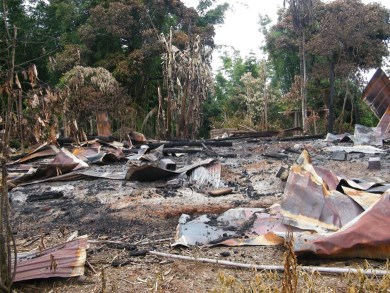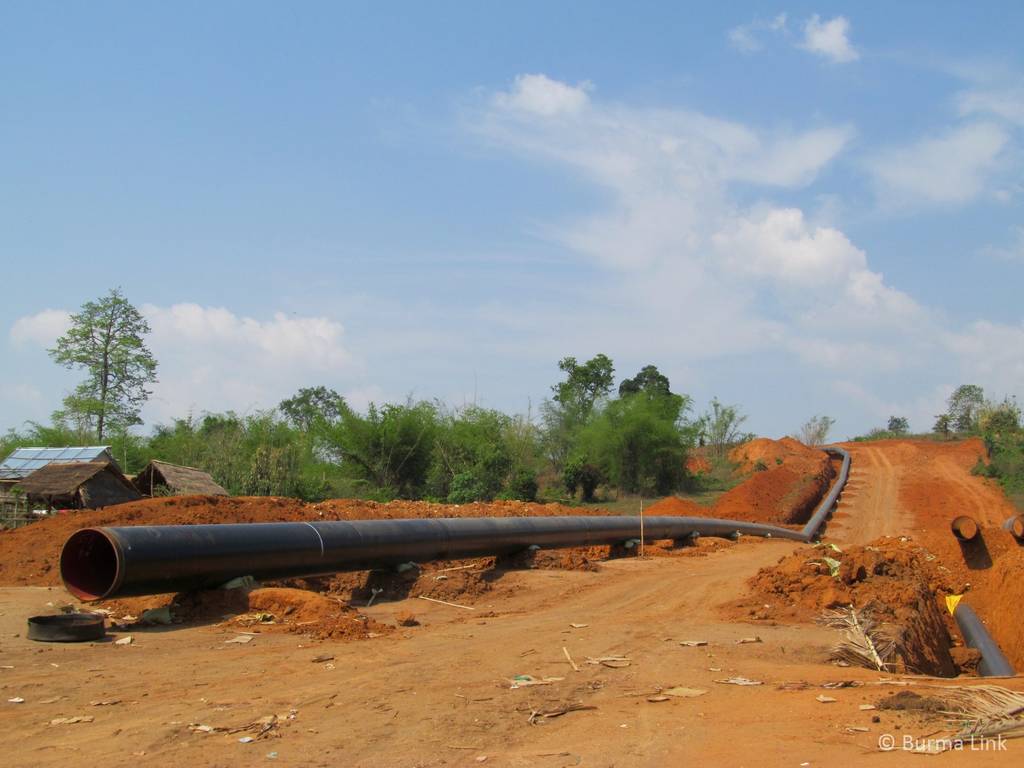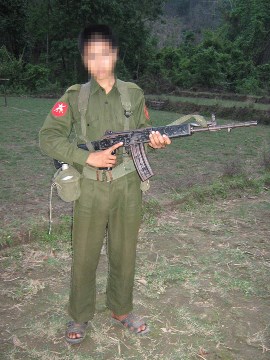In the 1960s the Burmese military started using the ‘Four Cuts’ strategy – an attempt to cut off food, funds, intelligence and recruits from armed ethnic opposition groups. The Burma Army began relocating, attacking and destroying villages, as well as killing everyone suspected of aiding the insurgency groups. Large areas were declared ‘free-fire’ zones, and entire communities were forced to move to fenced areas subjected to tight military control. Village chiefs and villagers suspected of supporting ethnic resistance movements were frequently detained, tortured, and killed, and villagers found outside the relocation sites were shot in line with the government’s ‘shoot-on-sight’ policy.

Homes and other buildings in Tha Dah Der village burnt to the ground by the Burma army in July 2010. (Photo: KHRG)
Four Cuts policy led to thousands of civilian deaths and the destruction of food, crops, and villages (BPHWT, 2006). Over 3,500 ethnic villages have been razed to the ground in the Karen, Karenni, and Shan states alone, more than in Darfur, Sudan (KWO, 2010). In the face of international criticism, the military government began to deny the existence of the Four Cuts policy in the late 1980s (KHRG, 2011a). It seems, however, that the policy has been practiced fairly recently (KHRG, 2011a; ND-Burma, 2012a; see also Burma Link’s interview with KWAT in 2015).
A corollary of the Four Cuts strategy is a policy known as ‘living off the land’ (see e.g. KHRG, 2008; South, 2011). As a result of this policy Burma Army units in many ethnic areas are dependent on their continued operations and very sustenance on exploiting local villagers for labour, rice, money and other basic supplies. Widespread forced relocations of communities in Burma have been the consequence of both the Four Cuts policy and the living off the land policy; by forcibly relocating villages into military-controlled population centres, the army units have had a ready pool of exploitable labour, land to grow crops on, people to tax, and other supplies that are required to sustain the army. While some abuse seems to be a direct result of a systematic military policy, such as Four Cuts, living off the land, and shoot-on-sight, other abuses seem to have been random acts of violence committed by aggressive soldiers (KHRG, 2008).
Government officials and troops have also deliberately targeted the broader society with the aim to intimidate the population and create a climate of fear in order to prevent people from opposing the government (ND-Burma, 2012a). This practice has been particularly prevalent in ethnic areas where, at times of conflict, torture of civilians is part of a wider strategy to keep the population so beaten down that they are unable or too afraid to support ethnic armed opposition groups. In this way, the use of torture can be seen as a corollary to Four Cuts policy.
Another policy leading to increased violence and conflict was the government’s demand, based on the 2008 Constitution, that remaining non-state armed ceasefire groups transform themselves into Border Guard Forces (BGF). Consequently, many longstanding ceasefire agreements unravelled and fighting between the government forces and ethnic armed groups spread during 2011. Conflicts broke out in Karen, Kachin, Shan, and Mon states (US State Department, 2011). Although the government ended its call for ceasefire groups to transform into BGF in October 2011, fighting continues particularly in northern Burma where a 17-year ceasefire was broken between the Kachin Independence Organisation (KIO) and the government in June 2011.
While non-state armed groups in Burma have also committed human rights abuses, including forced labour and recruitment of child soldiers, the Burma Army has by far been the primary force of violence and abuse in the country. The study of violations in eastern Burma highlights that ethnic nationalities are particularly vulnerable to the systematic abuses most often perpetrated by the Burmese military or its proxy armies (e.g. TBC, 2008; KHRG, 2011b).
Studies conducted before the ceasefire in the Karen State also showed that Burma Army presence resulted in increased persecution of nearby villages (KWO, 2010). PHR found that the abuse varied depending on the level of Burma Army control in the area; in areas where the army had complete control of the population abuses tended to be more in the form of extorting food and labour, whereas in areas where resistance movements were strong or in remote rural areas, human rights abuses tended to take the form of direct assaults on civilians (Davis, Gittleman, Sollom, Richards & Beyrer, 2012). PHR (Davis et al., 2012) found some violations up to eight times higher in areas occupied by the Burmese military than in areas contested by the Burmese military and ethnic armed opposition groups.
Research has also found a correlation between development projects and human rights violations in Burma, particularly with regards to land issues and forced displacement; economic development projects, such as hydroelectric dams, mines, pipelines and industrial areas, are all linked to human rights abuses (Davis et al., 2012; HURFOM, 2016a; see also Militarization & Human Rights Violations). PHR’s research found that human rights violations were up to ten times higher around an economic development project than in other areas (Davis et al., 2012). As ethnic nationality people tend to live in regions that are rich in natural resources, particularly Kachin and Shan states, scores of development projects have begun in these areas in recent years. These projects are typically implemented by Burmese and foreign companies in cooperation with the Burma Army, and according to civilians’ reports, the army has engaged in land confiscation, forced labour, and extortion around these development projects (e.g. KHRG, 2012a). An analysis of KHRG’s field information gathered between January 2011 and November 2012 indicated that natural resource extraction, industry and development projects resulted in land confiscation and forced displacement and were implemented without consulting, compensating, or often even notifying project-affected communities (KHRG, 2013a).

Pipeline in Hsipaw, northern Shan State. Pipelines from Burma to China have resulted in widespread land confiscation, environmental destruction, forced labour and other severe human rights abuses and more IDPs in northern Shan State. (Photo: Liz Bordo)
Many observers are concerned that new projects related to pipeline construction and maintenance in Kachin and Shan states will lead to increased human rights violations (e.g. Human Rights Watch, 2012c). The pipeline area in northern Shan State between Hsipaw and the China border is considered particularly problematic due to its passage through territory contested by armed groups. Sporadic fighting and offensives launched by the Burmese military in the area have caused thousands of villagers to flee their homes (Human Rights Watch, 2012c; TWO, 2014a, 2016a).
In Tenasserim Division, the government, in cooperation with Burmese and Thai construction companies, is planning on developing about 100 square miles of farmland into a manufacturing and shipping complex that is expected to displace about 30,000 people in 21 villages (see Dawei Project Watch). Human rights violations perpetrated by the Burmese army in the area were reported shortly after work began on the project in 2011, including attacks on civilians, forced labour, and land confiscation (see Dawei Project Watch).
In the Karen State, two development projects have recently led to increased human rights violations and armed conflict. In 2014, conflict broke out in what appeared to be part of a calculated military strategy by Burma Army to control territory around the planned Hatgyi Dam on the Salween River in the Karen State (KRW, 2014). In 2015, conflict also broke out around the Asian Highway project in the Karen State. A report by three Karen organisations published in September 2016 reveals how the Asian Highway has been built at the expense of communities and how the highway has contributed to conflict, displacement and involved numerous human rights violations (KESAN, KHRG & THWEE, 2016). In 2016, conflict has continued in the Karen State around the Asian Highway as well as the Hatgyi Dam, disaplceing over 5,000 Karen civilians (KRW, 2016).
Grave human rights abuses in Burma can occur both ceasefire and non-ceasefire areas. The ongoing war and Burma Army offensive in Kachin and Shan States has directly resulted in killings, torture, forced relocations, and other ill treatment, described as systematic war crimes by civil society groups (e.g. TWO, 2016a). Similar violations have occurred in the Karen State where the Burma Army has fought armed resistance groups for 70 years. Although there has been less conflict in the Karen State since the ceasefire was signed in January 2012 (followed by the ‘Nationwide’ Ceasefire in October 2015), sporadic conflict continues and has recently intensified, Burma Army has fortified its armed bases and increased its troops in the Karen areas, and civilians continue to suffer (KHRG, 2014a). Since 2012, KHRG has documented ongoing abuses, including arbitrary detention, violent abuse of civilians, killings, land confiscation, and forced labour demands by the Burmese military (KHRG, 2012b, 2014b, 2016).
Residents in ethnic areas have reported that ceasefires have not led to better protection of human rights, only to different types of violations (ND-Burma, 2013b). As ceasefires often lead to increased business and development projects, violations such as land confiscation and forced labour tend to increase in these areas. KHRG has indeed found both positive and negative changes in Karen areas after the ceasefire, the former including more stability and freedom to resume livelihoods and the latter serious abuses related to the ongoing militarisation of the region, particularly land confiscation (2012d, 2014a, 2016).
As in the Karen State, human rights violations have also continued to be prevalent in other areas with no active armed conflict. In the Kachin State, while the 1994 ceasefire agreement put an end to fighting, it did not put an end to human rights abuses by either party. Human Rights Watch (2012c) reports that at the time, the KIA continued to forcibly recruit and use child soldiers. Many Kachin villagers interviewed by Human Rights Watch also described an array of abuses by the Burma Army before and after the 1994 ceasefire, including abusive forced labour, torture, killings, rape, property destruction, land confiscation, and other abuses. The conflict that reignited in the Kachin State in 2011 has recently intensified, and for the first half of the year 2016, ND-Burma documented a stark increase in serious violations such as torture and killings by the Burma Army (ND-Burma, 2016a).
Research suggests that ceasefires do not end human rights violations by the Burma Army. Abuses and impunity have also continued unabated after the NLD-led Government took office in April 2016, with the types of abuses depending on whether the area is an active conflict zone or located in a ceasefire area, the most common perpetrator being the Burma Army. As was pointed out by Davis et al. (2012), ceasefire agreements should have mechanisms to monitor the specific violations that could occur in areas of economic development, and companies involved in development projects should ensure that they are not contributing to human rights violations.
Whilst the Burma Government led by State Counsellor Daw Aung San Suu Kyi must do more to end impunity and guarantee human rights for the people, the international community and human rights investigators must remain vigilant about monitoring human rights violations, humanitarian needs, and impunity in areas with recent ceasefire agreements.
Updated October 27, 2016
Continue to Consequences of Violence and Abuse

